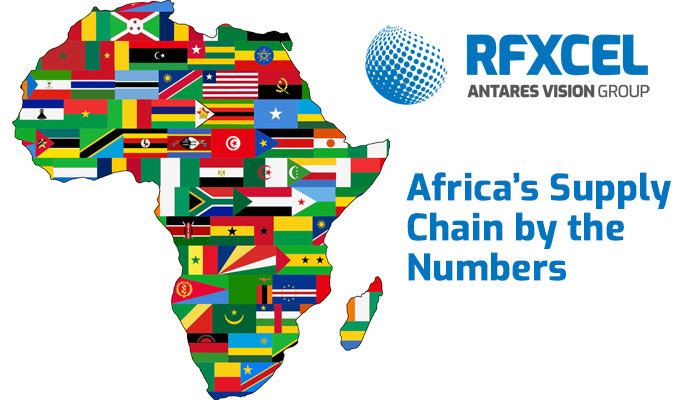Supply chains are about people. Yes, technology — like the digital solutions we provide — and regulations are important, but people are the true drivers, the alpha and omega. People design supply chains and make them run (efficiently and legally, we all hope). As consumers, people are the final destination of every supply chain; if you don’t understand their needs, wants, and habits, and if your products cannot reach them reliably, you’re out of business. The Africa supply chain is no exception.
In Part 1 of our series about the Africa supply chain, we’re looking at facts and figures about the almost 1.4 billion people on the continent. By understanding the people — where they live, their economies and how they work, and ambitious initiatives that will affect their daily lives — we provide the context for a broader discussion and understanding of the Africa supply chain. Let’s get started.
Africa by the numbers
Geography and population
Africa is big. It’s about 11.7 million square miles (30.3 million square km) total, and about 5,000 miles (8,000 km) from north to south and 4,600 miles (7,400 km) from east to west. Only Asia is bigger: 17.2 million square miles (almost 44.6 million square km).
There are 54 countries in Africa. As we said above, the population is approximately 1.4 billion — that’s about 17 percent of the world population. For comparison, there are roughly 4.6 billion people in Asia, 748 million in Europe, 654 million in Latin America and the Caribbean, 370 million in North America, and 42.5 million in Oceana. Africa is also the youngest continent in the world: The median age is 19.7 years. According to the World Bank, half of the population in Sub-Saharan Africa will be under 25 by 2050.
Africa has the highest growth rate in the world, and its population has increased every year since 2000, when it was approximately 811 million. By 2100, the population will approach parity with Asia. Nigeria is the most populous country, with 206 million people, followed by Ethiopia, which has 115 million. Egypt ranks third — 102 million people — and is the most populous country in in North Africa. (Be sure to read our overview of the Egypt pharmaceutical supply chain to learn about what’s happening there.)
The continent is home to between 1,500 and 2,000 languages, about one-third of the world’s languages. At least 75 of those have more than 1 million speakers.
Urbanization
Africa has led the world in urbanization this decade. As of 2021, 609 million people lived in urban areas; this could reach 722 million by 2026. According to the Population Division of the United Nations Department of Economic and Social Affairs, 22 cities in Africa are expected to grow at an average annual rate of more than 5 percent in the first half of the 2020s, and 58 are expected to grow at 4-5 percent. The two fastest-growing cities in the world are Gwagwalada, Nigeria, and Kabinda, Democratic Republic of the Congo. Cities in Angola, Tanzania, and Mozambique are topping current growth statistics, and by 2035, Africa’s fastest-growing cities are forecasted to be Bujumbura, Burundi, and Zinder, Nigeria.
Proliferation of mobile technology
According to the GSMA, an association representing mobile network operators around the world, 495 million people — 46 percent of the population — were subscribed to mobile services in Sub-Saharan Africa at the end of 2020. This was an increase of almost 20 million over 2019. By 2025, adoption of 4G will double to 28 percent (the global average is 57 percent), and 5G will reach 3 percent of total mobile connections.
GSMA reports that 40 percent of the population in Sub-Saharan Africa is under the age of 15. Overall, Africa’s very young population will drive mobile use. Importantly, we can also assume that this demographic will use their mobile devices for everything from banking and shopping to entertainment, creating opportunities for companies to connect to consumers and involve them in the Africa supply chain.
Economy
Pre-pandemic, United Nations statistical data showed that Africa’s economy grew by about 3.4 percent in 2019, “creating one of the longest stretches of uninterrupted positive economic expansion in [the continent’s] history.” This helped fuel a growth of the middle class year over year.
In 2020, Africa experienced a 3.4 percent contraction in gross domestic product (GDP).
According to the United Nations Industrial Development Organization (UNIDO) Industrial Development Report 2022: The Future of Industrialization in a Post-Pandemic World, the pandemic has caused considerable output loss in Africa, as it has in most of world. Here are projected output losses by 2021 for the “economy groups” in Africa:
- North Africa (four economies): 7.3 percent
- Less-developed countries (14 economies): 6.8 percent
- Sub-Saharan Africa (12 economies): 6.4 percent
For perspective, estimated output losses were 7.5 percent in West Asia (5 economies), 4.1 percent in Northern and Western Europe (4 economies), 2.7 percent in North America and Pacific (4 economies), 10.3 percent in less-developed countries in Asia, and 1.4 percent in China.
According to a quick online survey of Africa-based websites, the top job sectors on the continent are agriculture, which accounts for 15 percent of GDP; infrastructure; mining; service; banking and finance; information and communications technology; entrepreneurship; entertainment; and tourism. See here and here for more information.
In 2020, 453 million people were employed in Africa, with the majority in Eastern Africa. The two most populous countries, Nigeria and Ethiopia, had the highest working populations, about 56.6 million and 51.3 million, respectively.
According to the World Bank, regional growth in Africa projections look like this:
- Sub-Saharan Africa: Growth for 2022 and 2023 will remain just below 4 percent.
- East and Southern Africa: Growth of 3.4 percent in 2022; excluding Angola and South Africa, 4.3 percent growth is expected in 2022.
- West and Central Africa: Growth of 5.3 percent in 2022; the West African Economic and Monetary Union (Benin, Burkina Faso, Côte D’Ivoire, Guinea-Bissau, Mali, Niger, Senegal, and Togo) is projected to grow at 6.1 percent in 2022. Nigeria is expected to grow by 2.9 percent (African Development Bank Group).
Agenda 2063 and the Africa Supply Chain
Agenda 2063 “is Africa’s blueprint and master plan for transforming Africa into the global powerhouse of the future.” It is being implemented through five 10-year plans, the first of which is scheduled to end next year. Many of its Flagship Projects relate to modernizing and expanding infrastructure; therefore, they are directly related to the Africa supply chain. For example:
African High-Speed Train Network: The network will connect all countries’ capitals and commercial centers, including connecting the 16 landlocked countries to major seaports and neighboring countries.
Single African Air-Transport Market (SAATM): The goal is “the full liberalization of intra-African air transport services in terms of market access [and] traffic rights for scheduled and freight air services by eligible airlines, thereby improving air services connectivity and air carrier efficiencies.”
Continental Commodities Strategy: The goal is to move Africa away from being a raw materials supplier to “developing [its] commodities as a driver for achieving the structural, social, and economic transformation of the continent.” Integrating into regional and global value chains is a key part of the strategy.
The African Continental Free Trade Area (AfCFTA): The goal is to accelerate intra-African trade and boost Africa’s “trading position in the global market by strengthening [its] common voice and policy space in global trade negotiations.” Thirty-six countries had ratified the AfCFTA agreement as of February 5, 2021.
Final thoughts
To understand your supply chain, you have to understand people. We hope this overview of Africa was informative, showing where people live, how they work, the continent-wide trends, and what’s being done to ensure the Africa supply chain better serves every person in all 54 countries.
Everything we’ve talked about today influences the Africa supply chain; however, urbanization could be the most telling and important. As cities continue to grow — remember, urban populations are projected to reach 722 million by 2026 — people will demand more access to goods and services, and the supply chain will have to respond nimbly and efficiently. The proliferation of mobile devices and networks, especially among young people, is another important driver.
rfxcel understands supply chains. The technology, the regulations, and how they affect people. Move on to Part II of our Africa supply chain series, where we discuss recent developments and regulations in specific countries. And be sure to contact us if you have any questions or want a short demonstration of our solutions. We’d love to hear from you.
Last but not least, take a look at our other news from the Africa and Middle East region:





